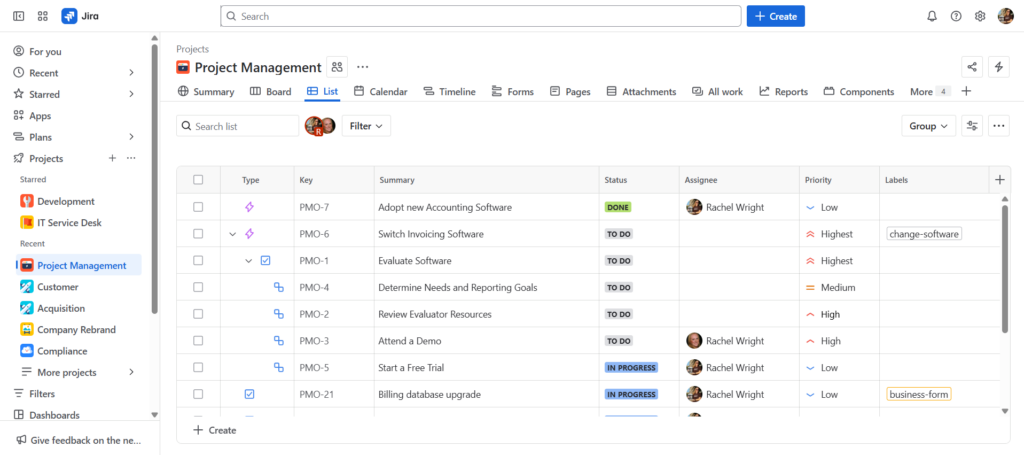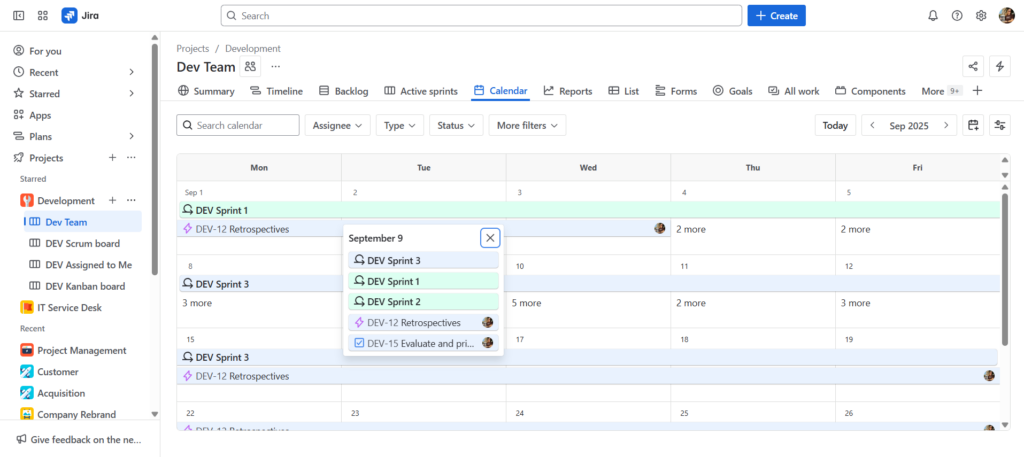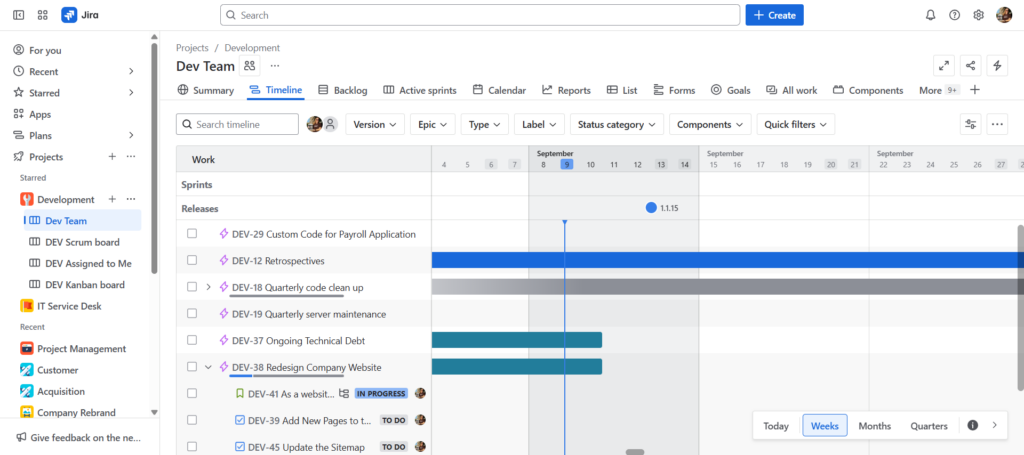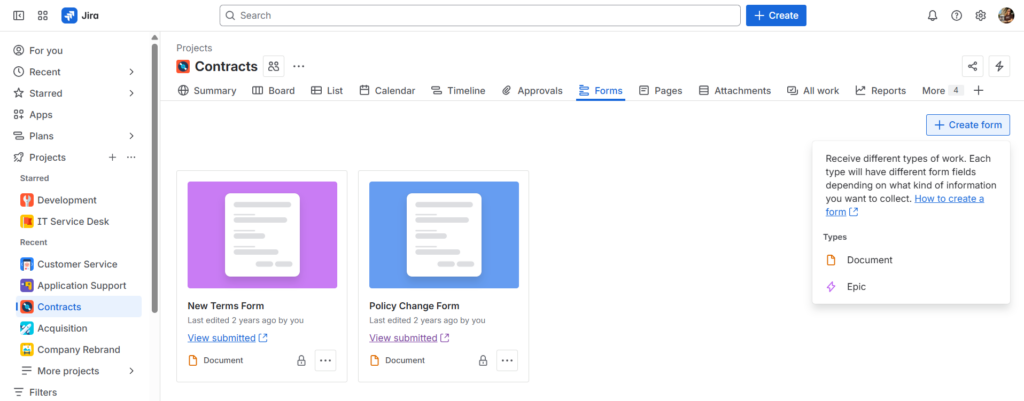Jira has multiple application types and each is built for a specific audience and use. In May 2024, Atlassian announced that in Cloud, Jira Software and Jira Work Management are combined under the brand name “Jira”. Therefore, in Cloud, the application types are now known as: Jira, Jira Service Management (JSM), and Jira Product Discovery (JPD). All types have the same look and feel but different features. The applications can be used separately or together. For example, your organization might use Jira but not Jira Service Management.
Additionally, each Jira application type contains different project types. Each has special features tailored to specific user audiences. Here are the major differences and how to select the best project type for your team’s needs.

Jira Project Types
Business Jira projects (formerly known as Jira Work Management in Cloud, and known as Jira Core in Server and Data Center) contain all the main Jira features like projects, work items, workflows, and users. This type is best for business teams and for managing initiatives, processes, and tasks.
Software Jira projects are designed for development teams and teams using a Scrum or Kanban methodology. It includes dev-specific features like sprints, story points, backlogs, and integration with tools like Bamboo and Bitbucket.
Jira Service Management projects are for support and IT service management teams.
Finally, in Cloud (only), there’s also Jira Product Discovery projects which help product managers collaborate and prioritize initiatives.
Business and Software Project Features
Business and software Jira projects contain the following unique views and features:
LIST VIEW
The list feature displays parent and child items in a expandable list format. It’s similar to the format presented after searching or viewing filter results but there’s no JQL query to construct. Instead, all items in the project are displayed and there’s an easy menu to filter items by assignee, component, work type, labels, priority, reporter, and status. You can also filter by items “due this week”. This feature is a quick and easy way to view work in a project without needing any query skills.
The best part of this view is that parent items can be expanded or collapsed to show or hide child items. This hierarchy capability is highly desired but missing in other areas of Jira. In the example screenshot, the PMO-1 Task is expanded and shows four Sub-tasks.

CALENDAR VIEW
The calendar view in Jira Cloud shows items based on start and end dates. This view also shows the work type, key, summary, and assignee. The filtering capabilities work the same as described in the “list” view.

TIMELINE VIEW
The timeline view includes a Gantt-type chart where item duration is represented by colored bars. Start dates, end dates, and assignees are displayed. Dependencies are created using the standard linked items feature and indicated using curved red lines. (Not pictured.) The same filtering abilities in the other views are present as well.

FORMS
The final special project feature in Jira Cloud is forms. Use a form to collect additional information without adding new Jira work types or custom fields. Each form has a unique URL that can be shared with any licensed Jira user. A Jira item is automatically created after any form submission.

Software Project Features
In addition to the views and features in business projects, software projects include the following development-specific features:
- Project templates for Scrum, Kanban, and bug tracking
- Scrum boards for teams that plan in chunks of work called “sprints”
- Kanban boards, for teams with less structured delivery schedules
- Sprints to manage iterations or scheduled work
- Sprint capacity planning (in Jira Cloud Premium and Enterprise) to avoid over or under resource utilization
- Story points for relative effort estimation (time-based estimation is also available)
- Backlog functionality to help teams prioritize future work
- Release tracking to manage deployments
- Fix versions to schedule work and affected versions to manage code changes
- Release tracks (in Jira Cloud Premium and Enterprise) to manage when and how software changes are released
- Roadmaps to view work in a Gantt-type format
- Additional built-in reports to track burndown and burnup, velocity, epics, releases, and more
- Integration with code and deployment tools like Bamboo and Bitbucket
- And more
Tip: Learn more about the software development life cycle (SDLC) and using Atlassian applications to plan, develop, test, and release software with my Planning and Releasing Software with Jira course.
Jira Service Management Projects
The service management project type helps support teams of all types manage their requests. Atlassian created Jira Service Management in 2013 after noticing that 40% of customers had adapted Jira to handle service requests. JSM is for tracking changes to systems, processes, or applications, resolving incidents and problems like an outage or security breach, fulfilling service requests like a password reset, new hardware, or issuing a mobile device, managing approvals of all kinds, and helping internal or external customers with whatever they need. Business teams can take advantage of JSM features too. For example, the HR team can collect benefits questions and reimbursement requests, the facilities team can receive requests for new desks and chairs, and the legal team can process contract review requests.
Sometimes teams have more than one project like a service-type project to support their “customers” and another business-type project to manage all their internal “to do” items. For example, the finance team can have a service project that every employee has access to. This project is used to collect employee reimbursement and purchase requests. They can also have a business project that only finance team members have access to. That project is used for tracking team tasks like maintaining reports and adding new employees to the payroll system.
Service Project Features
While you can certainly use a Jira project for support, a service management project takes support to the next level. JSM includes the following additional support-specific features:
- Project templates for ITSM, customer service, and other support type teams (in Jira Cloud)
- Dedicated queues to organize and categorize requests (in addition to standard JQL filtering capabilities)
- Request categories for segmenting service requests, changes, problems, and incidents (found in the Jira Cloud “IT service management” project template)
- Service Level Agreements (SLAs) to define goals and measure metrics like response or completion time
- A simple customer portal (aka “help center”) featuring a streamlined interface and slightly customizable display
- Integration with Confluence as a self-service knowledge base
- Asset and configuration management (in Jira Cloud Premium and Enterprise)
- Built-in reports for tracking agent workload, customer feedback, and requests deflected by self-help articles
- Better support for creating items via email (and from non-licensed users)
- An embeddable widget (in JSM Cloud) to create items from other web pages or applications
- Customizable notifications for customers
- Permission schemes allowing customer access
- A simple customer satisfaction (CSAT) survey to collect customer feedback
- Integration with monitoring, alert, and notification tools
- And more
Tip: Learn more about JSM users, features, and configuring support projects with my Jira Service Management: Administration course.
Jira Product Discovery
There’s also a newer project type is called Product Discovery and it’s intended for product managers. This application helps product and pipeline owners collect ideas, assess and prioritize them, and track them through delivery. This type is great for product teams managing strategic company priorities, a portfolio, or a product catalog. It has special features for tracking goals, roadmap management, and insights from customer relationship management applications.
Learn more about this project type at: https://www.atlassian.com/software/jira/product-discovery
License Differences
Access to business projects is available to all licensed users. Only Jira software users can leverage development specific features. Only JSM agents can use support features in service management projects. When choosing between application and project types, it’s important to compare pricing, project access, and feature differences. See Atlassian’s Jira product page and the table on the pricing page for additional feature information. Also see the JSM product page and its pricing page.
Tip: The user model is different in JSM. An agent is anyone providing support, managing the support team, or monitoring support team effectiveness. The agent is the technician who solves a problem or provides the requested help. An agent does all their work in Jira and requires a JSM license to use service features. A customer is anyone who requests support. Customers can include internal users, external users, employees, vendors, contractors, and anyone else who needs help. These users file support requests and view progress in a simplified interface called the customer portal or help center. Customers generally don’t access the area of Jira that agents use to fulfill requests. As such, they do not require a license.
How to Choose a Project Type
As you can see, there’s a lot to consider when selecting a Jira application type and project type. While it’s easy to switch between Jira project types in Server and Data Center, it’s a more involved process in Cloud.
Potential reasons to choose a business project type:
- The primary users manage initiatives, processes, and tasks
- Easier to use and navigate for less technical Jira users
- Cheaper user license fees
- The list, calendar, and timeline views are easy to use and don’t require JQL
- The forms feature is an interesting addition
Potential reasons to choose a software project:
- The primary users write, release, and deploy code, and/or use development tools like Bamboo or Bitbucket
- Backlog, sprint, and/or scrum board functionality is used to prioritize and schedule work
- Epics are used to categorize work
- Software users can access both software and business projects
- There’s a desire to track metrics like burndown, burnup, and velocity
Potential reasons to choose a service management project:
- The primary users provide service and support for products or applications, to other teams, or to internal or external customers
- Requestors don’t have Jira licenses
- Requestors are less technical users
- There are deadlines (SLAs) to meet for specific requestors or certain types of requests
- Note: Add similar capabilities to other project types using apps from the Atlassian Marketplace
- The team uses monitoring, alert, or ChatOps tools
- Note: Other project types can integrate with Slack and Microsoft teams as well
Can you think of other reasons to choose a specific project type? Please add your thoughts in the comments section below.
Related Articles
For related information on the different types of Jira and changes over the years, please see:
Evolution of Jira Design
Project Administration Links in Jira Software and Jira Service Management
Jira Server vs Jira Cloud Interface Comparison
Jira Cloud Navigation Comparison
